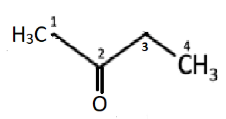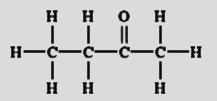
Write the structural formula for the IUPAC name: Butanone.
Answer
572.1k+ views
Hint: The important point one should take care about while writing the structural formula of any compound is the breaking of its IUPAC name to decipher its meaning. Ketone is the functional group in Butanone and has \[\left( { - C = O} \right)\] group in the structure.
Complete step by step answer:
Structural formula of a compound is used to identify the location of chemical bonds between the atoms of a molecule. It consists of symbols for the atoms connected by short lines. These lines represent the chemical bonds. They can be of two types- line structured and condensed structural formula.
According to IUPAC nomenclature, if organic compounds contain one principal functional group then the longest continuous chain of carbon atoms having the principal functional group is selected. In organic chemistry, functional groups are specific substituents in the molecules which are responsible for the characteristic chemical reactions of those molecules.
The word root for the given compound is butane. Ketone functional group is attached at the second position of butane and therefore, the numbering starts from the carbon of the ketone functional group. The suffix of the name shows the type of functional group present on the parent chain with higher priority i.e. ketone here denoted by ‘one’ in suffix. We can also name it as butan-2-one.
Hence, the structure of the following IUPAC name butanone can be:

From its structure shown above, we get its condensed structural formula as \[C{H_3}C(O)C{H_2}C{H_3}\] or \[{C_4}{H_8}O\]. Its line structural formula can be written as

Note:
It is also known as ethyl methyl ketone. The general formula of ketone Is \[{C_n}{H_{2n}}O\] where keto group has two alkyl groups attached to it each on either side and oxygen is connected to the carbon atom with two lines in between that represent a double bond.
Complete step by step answer:
Structural formula of a compound is used to identify the location of chemical bonds between the atoms of a molecule. It consists of symbols for the atoms connected by short lines. These lines represent the chemical bonds. They can be of two types- line structured and condensed structural formula.
According to IUPAC nomenclature, if organic compounds contain one principal functional group then the longest continuous chain of carbon atoms having the principal functional group is selected. In organic chemistry, functional groups are specific substituents in the molecules which are responsible for the characteristic chemical reactions of those molecules.
The word root for the given compound is butane. Ketone functional group is attached at the second position of butane and therefore, the numbering starts from the carbon of the ketone functional group. The suffix of the name shows the type of functional group present on the parent chain with higher priority i.e. ketone here denoted by ‘one’ in suffix. We can also name it as butan-2-one.
Hence, the structure of the following IUPAC name butanone can be:

From its structure shown above, we get its condensed structural formula as \[C{H_3}C(O)C{H_2}C{H_3}\] or \[{C_4}{H_8}O\]. Its line structural formula can be written as

Note:
It is also known as ethyl methyl ketone. The general formula of ketone Is \[{C_n}{H_{2n}}O\] where keto group has two alkyl groups attached to it each on either side and oxygen is connected to the carbon atom with two lines in between that represent a double bond.
Recently Updated Pages
Master Class 11 Chemistry: Engaging Questions & Answers for Success

Why are manures considered better than fertilizers class 11 biology CBSE

Find the coordinates of the midpoint of the line segment class 11 maths CBSE

Distinguish between static friction limiting friction class 11 physics CBSE

The Chairman of the constituent Assembly was A Jawaharlal class 11 social science CBSE

The first National Commission on Labour NCL submitted class 11 social science CBSE

Trending doubts
What is meant by exothermic and endothermic reactions class 11 chemistry CBSE

10 examples of friction in our daily life

One Metric ton is equal to kg A 10000 B 1000 C 100 class 11 physics CBSE

Difference Between Prokaryotic Cells and Eukaryotic Cells

What are Quantum numbers Explain the quantum number class 11 chemistry CBSE

1 Quintal is equal to a 110 kg b 10 kg c 100kg d 1000 class 11 physics CBSE




